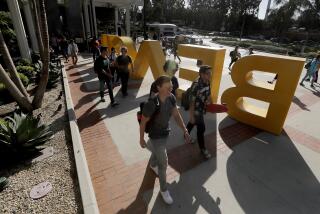NIH cuts put medical research at risk, scientists say, raising concerns at UC and elsewhere

- Share via
- The NIH said it is cutting medical research funding that universities use to pay for overhead costs.
- The move sparked concern at the University of California, which receives billions in annual NIH funding.
- Research into ‘life-saving treatments’ are at risk,’ UC said
Each year, the National Institutes of Health gives billions of dollars to the University of California to pay for research into cancer, Alzheimer’s, Parkinson’s, heart disease, diabetes and other diseases it has been at the forefront of studying for decades.
But a drastic cut to NIH funding under the Trump administration set to take place Monday has caused alarm among UC leaders and many medical researchers, who said the move would “jeopardize America’s research preeminence.”
Speaking to The Times since the cuts were announced Friday night, UC medical researchers expressed concerns about the future of their labs and lifesaving endeavors — as have others at universities and academic medical centers nationwide.
The NIH said late Friday that it would slash by more than half so-called “indirect funding” — overhead for research supplies, building maintenance, utilities, support staff and other costs — that institutions receive as part of medical research grants.
Beginning Monday, NIH-sponsored indirect funding will be capped at 15% of grants, down from 57% that many UCLA research projects receive and the 64% given at UC San Francisco, which has the highest rate in the UC system.
The University of California, the nation’s top recipient of federal research funding in higher education, is raising questions and concerns about the Trump administration’s pause in research grant reviews announced this week.
In its X post on the change Friday, the NIH shared a graphic that compared the indirect funding rates for Harvard, Yale and Johns Hopkins with their multibillion-dollar endowments. The highest among them, Harvard, was 69%.
The NIH’s move would save roughly $4 billion a year in tax dollars, the post stated. The agency said that more than a quarter of its $35 billion in research funding last year went to overhead. As a comparison, it cited private foundations, including the Chan Zuckerberg Initiative and the Gates Foundation, saying their overhead costs are 15% or lower.
“The United States should have the best medical research in the world,” the NIH said in guidance posted to its website. “It is accordingly vital to ensure that as many funds as possible go towards direct scientific research costs rather than administrative overhead.”
University researchers said the money, despite being labeled “indirect funding,” is essential to their work and pays to keep lifesaving science going — from ensuring the proper storage of biological samples to keeping alive animals for medical trials. They also contend that private foundations do not have to follow the same rules in how they categorize spending, saying it is unfair to compare overheads between the two.
California students sue Education Dept. over fears of Musk’s access to loan data as congressional members hold D.C. protest.
Republicans argue that the costs are superfluous, part of bloated spending of taxpayer funds that President Trump has appointed Elon Musk to pare down.
Scientists point out that universities have already been paying a greater share for research costs. Data from the National Center for Science and Engineering Statistics show that, since 1980, the federal slice of research support at universities has gone down 12% while university payments have gone up 11%.
Cuts could ‘imperil’ UC medical research
The NIH is the largest funder of UC research, providing $2.6 billion in the last academic year — 62% of the university’s federal awards of more than $4.2 billion.
In a statement, UC said that the “new administration guidance would imperil this vital support and jeopardize America’s research preeminence.”
“These time-honored university partnerships have led to some of the most powerful and impactful research discoveries in human history,” the statement said. “Life-saving treatments for cancer, diabetes, heart attacks, and strokes, including in children, and new technologies and industries that translate into hundreds of thousands of well-paying jobs are all at risk. America is first in research, but its dominance is not assured.”
On Saturday, UC officials were still analyzing the effect of the NIH move, and were in contact with UC lawyers, researchers and administrators on how to respond.
In an email to his science faculty after the NIH announcement, a UCLA dean said: “As with many announcements over the last several weeks, this no doubt causes significant anxiety. Please know that the leadership at UCLA and across the UC is working to understand the implications.”
White House defends move
The White House defended its action, saying in an email blast to media outlets Saturday that “the NIH did not announce any cuts to actual research.” It cited Vinay Prasad, a professor of epidemiology and biostatistics and medicine at UC San Francisco, who praised the NIH move on his blog.
The cut “might even mean more science. Less money spent on the administration is more money to give out to actual scientists,” wrote Prasad. “I am shocked to see researchers crying about how much money the university gets — it means more grants can be given per cycle.”
Several other UC researchers, many who had just applied for grant renewals after a recent application pause or were in the midst of assembling grant proposals, said they were stunned.
“All my research will be shut down if this goes through. There is no other way to say it. It will be done,” said Beate Ritz, a professor and vice chair of the epidemiology department at UCLA who has received at least $1 million a year for more than a decade from the NIH to research environmental pollution, Parkinson’s and Alzheimer’s. “It’s not my salary. I get paid by the state to teach. But it is the cost of much of everything else.”
Trump’s executive order calling on campuses to address antisemitism has university leaders, faculty and students concerned as the president vows to revoke visas of pro-Palestinian international students who have taken part in protests.
What is being cut
Indirect costs cover items outside of salaries, travel, supplies and other direct expenses. The indirect costs are negotiated between the university and the federal government — typically every three or four years for UC campuses — which is why the change surprised scientists.
Gina Poe, a neurobiology professor in UCLA’s David Geffen School of Medicine, said she feared that her decades of research into memory, sleep and post-traumatic stress syndrome were threatened.
Poe explained how her grant works. She receives $250,000 a year from the NIH to pay five undergraduate and graduate research assistants, among other expenditures, including rats and mice. This does not include her indirect funding.
With UCLA’s indirect cost rate of 57%, at first glance, it appears Poe would receive an additional $142,500 in such funding. But she said the math is more complicated and she gets much less.
The federal government, Poe said, deducts certain costs from the grant before it calculates indirect funding levels. Major equipment costs, tuition awards to students and more are not included. In the end, her NIH indirect funding totals an additional $114,000, which mostly goes to UCLA and to the university’s life sciences division to cover facilities costs and other expenditures.
Among the budget items indirect funding pays for: workers who care for rats and mice, feeding them and cleaning their cages. It also pays for medicine and veterinarian visits.
Under the new NIH formula, Poe’s indirect funding allowance would be minimal.
“The only way left for me to make up that money is to move my work to a private company, for UCLA to raise tuition to cover extra costs or to apply to private foundations where the competition is going to increase significantly for funding,” Poe said.
President Trump signals plans to weaken the Department of Education, throwing into question the fate of financial aid and funding for underserved students.
Vivek Shetty, a UCLA professor of oral and maxillofacial surgery and biomedical engineering and former Academic Senate chair, expressed concerns that U.S. research power could be diminished.
“America’s global leadership in science and technology wasn’t built on genius alone. It relied heavily on infrastructure and systems that allowed universities to transform ideas into innovations. Cripple that infrastructure, and the next medical or AI advancement will happen elsewhere — taking with it not just jobs and prestige, but also the economic vitality and societal progress that innovation brings,” Shetty said.
The funding change has hit a particular nerve at universities since Trump’s inauguration. Many administrators have felt under the microscope from a president who has spoken out against what he describes as “Marxist” universities overrun with leftists.
Last month, UC officials raised concerns after a temporary NIH pause on research grant reviews. Trump’s executive orders have also targeted diversity, equity and inclusion programs — including in federal grants and programming. On Wednesday he signed an executive order designed to ban transgender athletes from participating in women’s or girls’ sporting events.
Times Staff Writer Corinne Purtill contributed to this story.
More to Read
Sign up for Essential California
The most important California stories and recommendations in your inbox every morning.
You may occasionally receive promotional content from the Los Angeles Times.
















